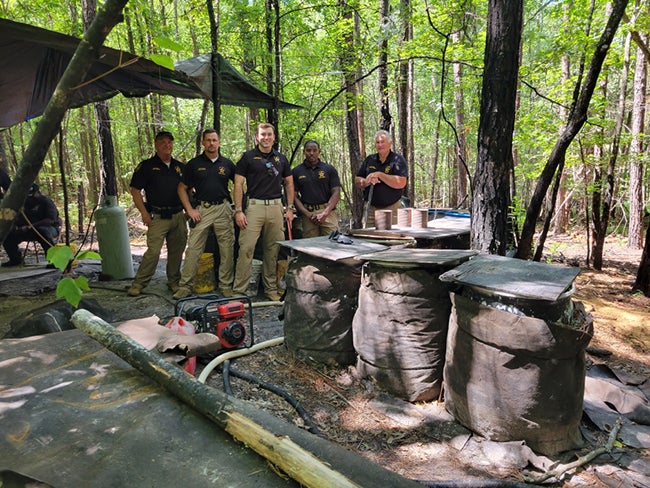Pronto ‘okrie’ patch benefits from old-fashioned growing techniques
Published 11:00 pm Friday, September 6, 2013
Don Renfroe is just plain “whupped.”
He has whupped “okrie” until he wore himself slap out.
Renfroe, laughingly, lapsed into the dialect of the old folks who believed in the old ways, stood by them, practiced them and passed them down to anyone who was fool hearted enough to give them a try.
Renfroe was fool hearted enough to whip the okra on his patch in Pronto.
He admitted that he was a bit hesitant to lay a stick to his okra patch. But, “why not?”
“The patch was green and growing but it didn’t have one single bloom,” Renfroe said, as he pushed the cap back on his head. “This dirt up around Pronto has always been good for growing peas, cotton, whatever but the ‘okrie’ just wasn’t making.”
Renfroe had kind of gotten pressured into planting the okra patch. He likes fried okra but it stops right there. He doesn’t like that “slimy, boiled stuff.” So, he had no need or desire to plant an okra patch.
But when kinfolks called and a little Pronto pride rushed in, Renfroe decided it was time to put his hand to the plow, so to speak.
Bill Hixon, Renfroe’s uncle, is mighty fond of okra. He likes it any way it’s prepared. He could eat it three times a day and still want more. So, it would seem that Hixon would have a huge okra patch and grow enough okra so that he could have it anytime and every time he wanted it.
But the land up around Buckhorn Creek where Hixon lives is not conducive to good okra growing. So knowing how much his dad likes okra, Billy Hixon took the matter into his own hands.
The younger Hixon had spread the litter from his chicken houses on already fertile ground in Pronto. He knew it would be a prime place for growing okra.
“Billy handed me a sack of okra seeds and asked me to plant them so maybe his dad could get his fill of ‘okrie,’” Renfroe said.
When Renfroe planted the seeds, he envisioned enough okra to feed China. But it was not to be. The okra grew and grew but it did not bloom.
One day as Renfroe stood at the okra patch pondering the situation, a neighboring farmer stopped his truck, leaned out the window and called to Renfroe, “You gotta, whup it!”
Now, the practice of “whuppin’ okrie” was not foreign to Renfroe.
“Fletcher Rodgers used to whup okrie with a dogwood switch or a brush broom, whatever you call it,” Renfroe said. “He said you had to whup okrie to get it to make. Fletcher was into all kinds of voodoo stuff. Most folks thought he was crazy. But his okrie bloomed and made.”
And, then there was Dave Moneyham, who had been successful at growing okrie on Buckhorn Creek.
“Dave’s daddy was born a slave and he practiced the old ways,” Renfroe said. “Dave said his daddy whupped his okrie with a hickory stick, the same hickory stick that he whupped Dave with.”
Renfroe started to think that maybe, just maybe, he might take a stick to his okrie. After all, his neighbor had said, “It’s not gonna make until you whup it!”
So, Renfroe took a hickory stick to his okrie patch. He drew back that stick and whupped and whupped the okra until he couldn’t lift his arm one more time.
After the whuppin’ the okrie took, it straightened up. It grew; it bloomed; it made … and made … made.
The stalks grew stout and tall. So tall that Renfroe has to climb a 12-foot ladder to harvest the okra that’s growing at 14 feet – and rising.
“I’ve never seen so much okrie,” Renfroe said. “I whupped it and it whupped me.”
But folks all around the county have benefited from the bountiful harvest, Renfroe included. And especially his Uncle Bill, whose wife, Betty, is “one more good country cook.”
“Betty is one of the best cooks anywhere,” Renfroe said. “I mean she can cook.”
And, she invited Renfroe over for an okra dinner.
“We had fried okra, boiled okra and okra in the butterbeans and the best cornbread anywhere,” Renfroe said. “Betty apologized for not having meat but we didn’t need meat. We had okrie.”
Thankfully, okra is in high demand. Fried okra is a popular side item. It’s on most buffet lines and offered on meats and threes. Those who cook the old-time way say that a pod or two of okra cooked in peas and butterbeans gives them a special flavor. And, pickled okra is now a hot item.
Renfroe said he has endowed a distant neighbor with five one-gallon buckets of okra for the purpose of pickling.
The future of okra looks promising – fried, boiled, pickled – anyway you like it.
All it takes for a plentiful okra harvest is a putting a good whuppin’ on it and it will bloom and make and make and make, according to Renfroe.
As an afterthought, Renfroe has decided that whuppin’ the “okrie” knocks the leaves off, allowing the sun to filter through so the plants will bloom and produce.
“Okrie needs a good whuppin’ or it won’t make. That might sound crazy but it’s just that simple,” Renfroe said.






